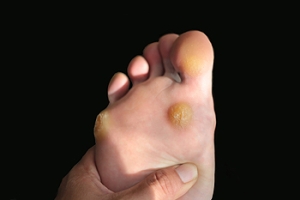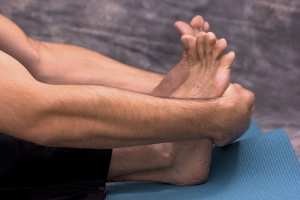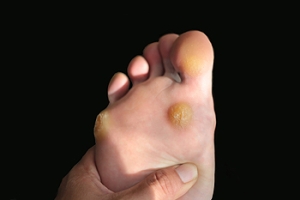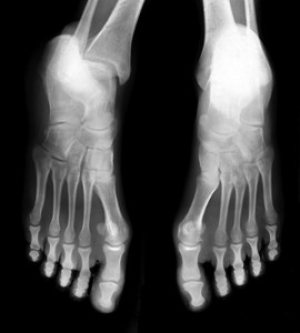
Common Symptoms of Corns
 If you have noticed a thickened layer of skin, often appearing in a small, ball-like shape, you may have developed a foot condition known as a corn. Corns generally form due to excess pressure put on the soles of the feet, and are known to be recurring if not properly treated. Corns are generally sore to the touch and may become increasingly more painful overtime. To help treat this condition, it may be beneficial to wear corn caps, have cryosurgery performed, or wear shoe inserts for extra support and cushion. Some patients have found soaking their feet in warm water followed by filing their corn with a pumice stone to be helpful in relieving discomfort. To determine which treatment option is best for you, and to prevent corns from recurring, it’s suggested you consult with your local podiatrist.
If you have noticed a thickened layer of skin, often appearing in a small, ball-like shape, you may have developed a foot condition known as a corn. Corns generally form due to excess pressure put on the soles of the feet, and are known to be recurring if not properly treated. Corns are generally sore to the touch and may become increasingly more painful overtime. To help treat this condition, it may be beneficial to wear corn caps, have cryosurgery performed, or wear shoe inserts for extra support and cushion. Some patients have found soaking their feet in warm water followed by filing their corn with a pumice stone to be helpful in relieving discomfort. To determine which treatment option is best for you, and to prevent corns from recurring, it’s suggested you consult with your local podiatrist.
If you have any concerns regarding your feet and ankles, contact one of our podiatrists of Pennsylvania. Our doctors will treat your foot and ankle needs.
Corns: What Are They? and How Do You Get Rid of Them?
Corns can be described as areas of the skin that have thickened to the point of becoming painful or irritating. They are often layers and layers of the skin that have become dry and rough, and are normally smaller than calluses.
Ways to Prevent Corns
There are many ways to get rid of painful corns such as wearing:
- Well-fitting socks
- Comfortable shoes that are not tight around your foot
- Shoes that offer support
Treating Corns
Treatment of corns involves removing the dead skin that has built up in the specific area of the foot. Consult with Our doctors to determine the best treatment option for your case of corns.
If you have any questions please feel free to contact one of our offices located in Plymouth Meeting and Ambler, PA . We offer the newest diagnostic and treatment technologies for all your foot and ankle needs.
Everything You Need to Know About Corns
Corns are hard and thick areas of skin that form as a result of constant rubbing, friction, or pressure on the skin. They are patches of dead skin with a small plug toward the center. They may appear on the tops and sides of toes and can make walking painful.
Soft corns are typically thinner with a white color and rubbery texture. Soft corns tend to appear between the toes. Seed corns are another type of corn that appear in clusters and can be tender if they are on a weight-bearing part of the foot. Seed corns usually appear on the bottom of the foot and are likely caused by a blockage in sweat ducts.
While corns and calluses are somewhat similar, calluses are a bit different. Calluses are a patch of dead skin that can occur anywhere on the body. In comparison to corns, calluses are usually a bit larger in size. However, both corns and calluses are caused by increased friction on the skin.
There are some risk factors that may increase your chances of developing corns and calluses. If you have bunions, hammertoe, or a bone spur, you are more likely to develop a corn or callus on your foot.
While Corns and Calluses tend to disappear when the friction to the affected area ceases, the help of a podiatrist may be useful in the removal process. It is important to remove the dead skin around the area and this may be done in a few different ways. Moisturizing creams may be helpful in softening and removing the dead skin around the callus. You should never use razors or other pedicure equipment to remove your corns. Doing this may worsen your corn or callus and cause infection.
In some cases, corns and calluses may be caused by abnormal foot structure or walking motion. In such a case, you should seek a podiatrist’s assistance in order to correct the issue.
Stretches You Can Perform to Help Heal a Sprained Ankle
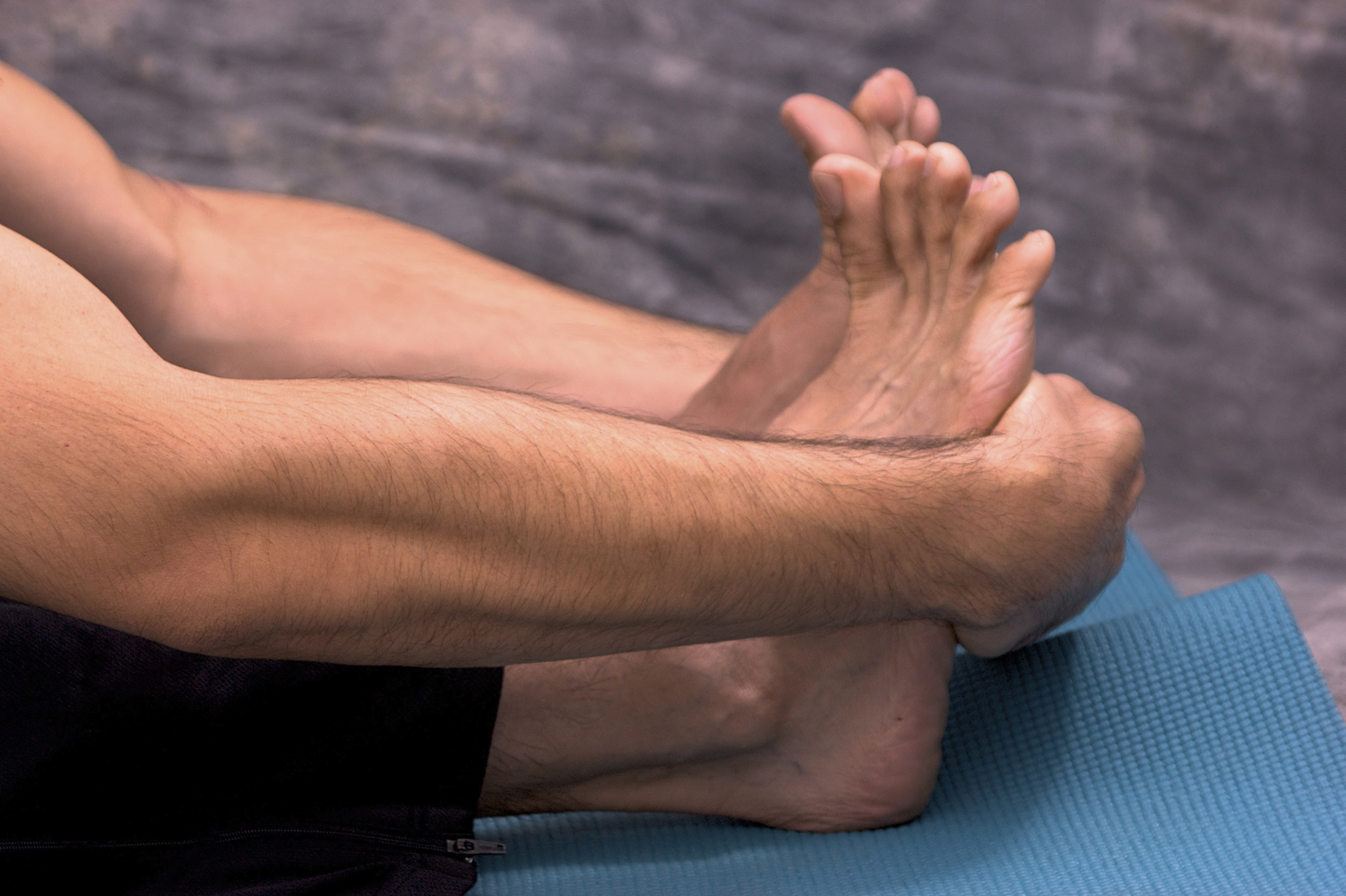 When healing from a sprained ankle, it’s important that you slowly and carefully build the muscles around the affected area. If you’re recovering from a mild sprain, you should be able to start practicing low impact exercises within a few days of having rested your foot. If you’re somebody who likes to regularly stay active, it’s important that you adapt your exercise routine around your sprained ankle, that way you can prevent injuring it further. The exercises you perform to help heal your ankle should focus on benefiting your range of motion, balance, strength, and flexibility. One simple exercise that can be performed to help your range of motion is referred to as ankle circles. This exercise is done by sitting in a chair with your ankle resting on the opposite knee. Slowly begin to rotate your ankle in a clockwise motion, then counterclockwise. Switch ankles and repeat this motion. Another stretch known as band pushes can be particularly beneficial for strengthening your ankle joints. To perform this stretch, sit flat on the floor with your legs straight out and place a resistance band around the ball of your foot. Begin pushing your foot against the band with your toes pointed slightly forward. For more advice on what stretches can help heal a sprained ankle, please consult with a podiatrist.
When healing from a sprained ankle, it’s important that you slowly and carefully build the muscles around the affected area. If you’re recovering from a mild sprain, you should be able to start practicing low impact exercises within a few days of having rested your foot. If you’re somebody who likes to regularly stay active, it’s important that you adapt your exercise routine around your sprained ankle, that way you can prevent injuring it further. The exercises you perform to help heal your ankle should focus on benefiting your range of motion, balance, strength, and flexibility. One simple exercise that can be performed to help your range of motion is referred to as ankle circles. This exercise is done by sitting in a chair with your ankle resting on the opposite knee. Slowly begin to rotate your ankle in a clockwise motion, then counterclockwise. Switch ankles and repeat this motion. Another stretch known as band pushes can be particularly beneficial for strengthening your ankle joints. To perform this stretch, sit flat on the floor with your legs straight out and place a resistance band around the ball of your foot. Begin pushing your foot against the band with your toes pointed slightly forward. For more advice on what stretches can help heal a sprained ankle, please consult with a podiatrist.
Stretching the feet is a great way to prevent injuries. If you have any concerns with your feet consult with one of our podiatrists from Pennsylvania. Our doctors will assess your condition and provide you with quality foot and ankle treatment.
Stretching the Feet
Being the backbone of the body, the feet carry your entire weight and can easily become overexerted, causing cramps and pain. As with any body part, stretching your feet can serve many benefits. From increasing flexibility to even providing some pain relief, be sure to give your feet a stretch from time to time. This is especially important for athletes or anyone performing aerobic exercises, but anyone experiencing foot pain or is on their feet constantly should also engage in this practice.
Great ways to stretch your feet:
- Crossing one leg over the others and carefully pull your toes back. Do 10-20 repetitions and repeat the process for each foot
- Face a wall with your arms out and hands flat against the wall. Step back with one foot and keep it flat on the floor while moving the other leg forward. Lean towards the wall until you feel a stretch. Hold for 30 seconds and perform 10 repetitions for each foot
- Be sure not to overextend or push your limbs too hard or you could risk pulling or straining your muscle
Individuals who tend to their feet by regular stretching every day should be able to minimize foot pain and prevent new problems from arising.
If you have any questions, please feel free to contact one of our offices located in Plymouth Meeting and Ambler, PA . We offer the newest diagnostic and treatment technologies for all your foot care needs.
How to Stretch Your Feet
Your feet endure a great amount of stress each day from constantly allowing us to move around. It is important to stretch your feet to help prevent them from becoming injured. Your toes may easily deform into unhealthful positions if they are not stretched.
One of the most common reasons for toe deformities are the shoes you may be wearing. Shoes that are too tight may fold and shift the toes out of place. Heeled shoes may also push your toes upward. Forcing your toes into an unnatural position which may cause the muscles to tighten and prevent them from reverting to normal length. Another common reason is improper use of foot muscles. Many people fail to use the muscles in their feet or toes when they walk. Lastly, the positioning of your feet while walking may also cause toe deformities. If you walk with your feet facing outward, your “push-off” phase is on the side of your big toe instead of the bottom of your foot. This may cause the big toe to eventually tighten into a new shifted position.
There are many reasons why stretching your toes may be helpful. One reason is that healthy spacing may aid in avoiding calluses and other injuries that are caused by rubbing. Stretching will also prevent you from developing toes that curl, hammertoes, or bunions.
A great way to stretch your toes is to place them in your hands and bend them all downward; this will help you stretch the top of your foot. Next, you should repeat this process but instead bend them upward enough to feel a nice stretch in the bottom of your foot. You should then try to pull each toe apart from the next and pull any toes that are bent upward until they are back downward.
If you are looking to practice stretching your entire foot, you can try a towel stretch. This is done by sitting on the floor with your legs in front of you. Take a towel and wrap it around your toes. Afterward, pull the towel toward you with your toes and hold this position for 15 to 30 seconds before releasing. Practice this stretch for three sets. Another stretch your feet are towel lifts. This is done by sitting in a chair and trying to pick a towel up from the ground with your toes. Try lifting the towel with your little toes for five sets before switching feet.
If you are an athlete, or exercise often, it is especially important for you to practice stretching your feet. Those who suffer from foot pain caused by poor footwear, plantar fasciitis, or long hours of standing at work may also benefit from foot exercises.
Common Signs Of Plantar Warts
 Patients who have had a plantar wart are often aware of the pain and discomfort this ailment may cause. It is defined as a virus that forms a wart on the sole of the foot. It differs from a common wart that is found on the hands because it grows into the bottom of the foot. This is a result of the pressure that comes from walking and standing for the majority of the day. Some of the symptoms that are associated with this condition can consist of extreme pain and discomfort, and tiny black dots may form in the center of the wart. It is considered to be a contagious virus, and may live on the surfaces of public pools, locker rooms, and communal shower room floors. If you notice a small, rough area on the bottom of your foot, you may have developed a plantar wart, and it is suggested that you consult with a podiatrist who can offer you the best treatment options.
Patients who have had a plantar wart are often aware of the pain and discomfort this ailment may cause. It is defined as a virus that forms a wart on the sole of the foot. It differs from a common wart that is found on the hands because it grows into the bottom of the foot. This is a result of the pressure that comes from walking and standing for the majority of the day. Some of the symptoms that are associated with this condition can consist of extreme pain and discomfort, and tiny black dots may form in the center of the wart. It is considered to be a contagious virus, and may live on the surfaces of public pools, locker rooms, and communal shower room floors. If you notice a small, rough area on the bottom of your foot, you may have developed a plantar wart, and it is suggested that you consult with a podiatrist who can offer you the best treatment options.
Plantar warts can be very uncomfortable. If you need your feet checked, contact one of our podiatrists from Pennsylvania. Our doctors will assist you with all of your foot and ankle needs.
About Plantar Warts
Plantar warts are the result of HPV, or human papillomavirus, getting into open wounds on the feet. They are mostly found on the heels or balls of the feet.
While plantar warts are generally harmless, those experiencing excessive pain or those suffering from diabetes or a compromised immune system require immediate medical care. Plantar warts are easily diagnosed, usually through scraping off a bit of rough skin or by getting a biopsy.
Symptoms
- Lesions on the bottom of your feet, usually rough and grainy
- Hard or thick callused spots
- Wart seeds, which are small clotted blood vessels that look like little black spots
- Pain, discomfort, or tenderness of your feet when walking or standing
Treatment
- Freezing
- Electric tool removal
- Laser Treatment
- Topical Creams (prescription only)
- Over-the-counter medications
To help prevent developing plantar warts, avoid walking barefoot over abrasive surfaces that can cause cuts or wounds for HPV to get into. Avoiding direct contact with other warts, as well as not picking or rubbing existing warts, can help prevent the further spread of plantar warts. However, if you think you have developed plantar warts, speak to your podiatrist. He or she can diagnose the warts on your feet and recommend the appropriate treatment options.
If you have any questions please feel free to contact one of our offices located in Plymouth Meeting and Ambler, PA . We offer the newest diagnostic and treatment technologies for all your foot and ankle needs.
What Are Plantar Warts?
Plantar warts are described as small growths that appear on the heels or other areas of the feet that bear a large amount of weight. The pressure in these areas causes plantar warts to hide behind thick layers of skin called calluses. In most cases, plantar warts are not a serious health issue, and they usually go away without treatment. However, it is still important be mindful of them.
Plantar warts are caused by infections with human papillomavirus (HPV) in the outer layer of skin on the soles of the feet. The plantar warts then develop when the virus enters the body through weak spots at the bottom of the feet, such as tiny cuts and breaks. Plantar warts are not guaranteed for all who encounter the virus. Everyone responds differently to the affects of HPV.
Plantar warts are most common in the following groups: children and teenagers, people with weakened immune systems, people with history of plantar warts, and people who walk barefoot. Exposure to HPV is common in environments such as locker rooms or pool areas.
One of early signs to look out for is a callus, since many plantar warts hide behind them. You can also locate these warts by looking for small, fleshy, rough, grainy growths near the base of the toes and the heel. Early signs of plantar warts are shown by black pinpoints, which are small, clotted blood vessels. Lesions that interrupt normal lines and ridges in the skin of your foot may also be a sign of plantar warts. Any feeling of pain while walking or standing can also be a symptom of plantar warts.
Although most cases are not serious, some conditions may require a visit to your podiatrist. If you are uncertain that your lesion is a wart, if you have diabetes, or if you are experiencing bleeding, you may need to see a seek professional treatment. Your doctor may offer treatments such as prescribing stronger peeling medicine or using cryotherapy by applying liquid nitrogen to the wart. More serious cases may require minor surgery or laser treatment.
There are simple solutions available to help prevent plantar warts. One common task is to avoid walking barefoot in swimming pool areas and locker rooms, as this is where HPV is commonly present. Keeping your feet clean and dry, while changing shoes and socks daily can also help prevent future plantar warts. If you know someone who has plantar warts, it is important to avoid direct contact with their warts. You should also refrain from picking or scratching your wart if you happen to develop one.
Effects of Having a Stress Fracture
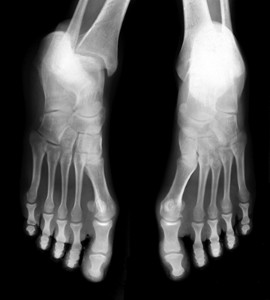 Stress fractures refer to having small breaks in the bone, commonly found in the second and third metatarsals of the foot. Stress fractures may not be obvious at first, however they tend to worsen overtime if not treated, and can be very painful. They typically occur due to overuse in a sporting activity, and can be prevented by gradually intensifying your workout and properly warming up before practicing an intense, high energy activity. It’s also important you wear footwear that gives your feet needed support, especially if you are running or jogging on uneven, or rugged surfaces. In terms of treatment, it is suggested that you get plenty of rest, treat the area with ice, and keep the foot elevated to avoid further swelling. We recommend you consult with a podiatrist for a proper diagnosis and an advised treatment plan.
Stress fractures refer to having small breaks in the bone, commonly found in the second and third metatarsals of the foot. Stress fractures may not be obvious at first, however they tend to worsen overtime if not treated, and can be very painful. They typically occur due to overuse in a sporting activity, and can be prevented by gradually intensifying your workout and properly warming up before practicing an intense, high energy activity. It’s also important you wear footwear that gives your feet needed support, especially if you are running or jogging on uneven, or rugged surfaces. In terms of treatment, it is suggested that you get plenty of rest, treat the area with ice, and keep the foot elevated to avoid further swelling. We recommend you consult with a podiatrist for a proper diagnosis and an advised treatment plan.
Activities where too much pressure is put on the feet can cause stress fractures. To learn more, contact one of our podiatrists from Pennsylvania. Our doctors can provide the care you need to keep your pain free and on your feet.
Dealing with Stress Fractures of the Foot and Ankle
Stress fractures occur in the foot and ankle when muscles in these areas weaken from too much or too little use. The feet and ankles then lose support when walking or running from the impact of the ground. Since there is no protection, the bones receive the full impact of each step. Stress on the feet can cause cracks to form in the bones, thus creating stress fractures.
What Are Stress Fractures?
Stress fractures occur frequently in individuals whose daily activities cause great impact on the feet and ankles. Stress factors are most common among:
- Runners
- People affected with Osteoporosis
- Tennis or basketball players
- Gymnasts
- High impact workouts
Symptoms
Pain from the fractures occur in the area of the fractures and can be constant or intermittent. It will often cause sharp or dull pain with swelling and tenderness. Engaging in any kind of activity which involves high impact will aggravate pain.
If you have any questions please feel free to contact one of our offices located in Plymouth Meeting and Ambler, PA . We offer the newest diagnostic and treatment technologies for all your foot and ankle needs.
Dealing with Stress Fractures of the Foot and Ankle
Stress fractures are small breaks in the bone that are caused by repetitive stress. They typically occur due to overuse, forcing the bones of the foot or ankle to continually absorb the full impact of each step taken. Stress fractures can also be caused by abnormal foot structure, osteoporosis, bone deformities, or wearing improper footwear during exercise.
Stress fractures are common for individuals whose daily activities cause high levels of impact on their feet and ankles. Those who run, play tennis or basketball, or practice gymnastics tend to experience these fractures more frequently. Anyone is susceptible to this problem, though. Individuals who are normally sedentary and suddenly begin an intense, high impact workout may sustain stress fractures. This is because their muscles are not yet strong enough to handle and cushion the intensity of their activity. Osteoporosis may also cause someone to get stress fractures, because the disease weakens an afflicted person's bones and makes it easier for them to break down.
Pain from stress fractures typically occurs in the general area of the fracture. Pain can also manifest as “pinpoint pain” or pain that is felt when the site of the injury is touched, and can be accompanied by swelling. It may occur during or after activity, and it may disappear while resting and return when standing or moving. Engaging in any kind of activity, high impact or otherwise, will aggravate the pain. If the intensity of the activity increases before the stress fracture has properly healed, it can cause a full fracture.
Treatment can vary depending on the individual and the degree of injury. The primary way to treat a stress fracture is to rest the hurt foot. Some fractures will heal quickly with only a little bit of rest, while others may require a long rest period and the use of crutches, immobilization, or physical therapy. Under certain circumstances, surgery may be required to install support pins around the fracture to assist in healing.
If you are undergoing a new exercise regimen in running or some other kind of high impact activity, set incremental goals on a weekly basis so you can build up muscle strength. Make sure to wear supportive shoes to better protect you feet.
If you begin to experience any symptoms of stress fractures, you should stop exercising and rest. If the symptoms persist, consult with your podiatrist. Remembering these tips can help you prevent stress fractures to your foot and ankle, and allow you to continue living normally.


